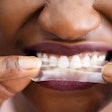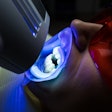
A new study examining the color stability of 10 resin-based restorative materials has found that while clinically relevant color changes occurred immediately after polymerization, a month later the color changes were negligible (Journal of Esthetic and Restorative Dentistry, June/July 2012, Vol.24:3, 185-199).
Color stability is a major challenge for clinicians despite significant developments to improve the optical properties of composites, the study authors noted.
"As newer and improved formulations of resin composite materials continue to develop, providing a wide array of clinical applications, it becomes essential for clinicians to understand their optical properties so that shade mismatch issues can be minimized," study author Camila Sabatini, DDS, an assistant professor in the School of Dental Medicine at State University of New York at Buffalo, told DrBicuspid.com.
Dr. Sabatini and her co-researchers evaluated the color changes of 10 commercially light-activated resin composite systems immediately after polymerization, 24 hours after polymerization, and after one month of storage.
According to the study authors, the tested composites included some of the most representative hybrid, microhybrid, and nanohybrid materials in the U.S.: CeramX (Dentsply Caulk), Filtek Supreme (3M ESPE), Four Seasons (Ivoclar Vivadent), Tetric EvoCeram (Ivoclar Vivadent), Point 4 (Kerr Dental), Premise (Kerr Dental), Venus (Heraeus Kulzer), Gradia Direct (GC America), Vit-l-Escence (Ultradent Products), and Artiste (Pentron Clinical Technologies).
Clinically relevant color changes
The researchers prepared five disks of two different thicknesses (1 mm and 3 mm) in two shades (A3 and bleach) from the brands of resin composite, recorded color measurements using a colorimeter, and expressed them in terms of the CIE L*a*b* scale.
“Resin color mock-up for shade selection remains the standard recommended procedure.”
— Camila Sabatini, DDS
The CIE L*a*b* scale, developed by the International Commission on Illumination (Commission Internationale d'Eclairage), is commonly used to describe color characteristics of an object based on three parameters: lightness-darkness (L*), red-green (a*), and yellow-blue (b*).
The researchers calculated the color change from baseline to immediate polymerization between immediate polymerization and 24 hours and between 24 hours and one month. Values ΔE ≥ 3.3 were considered clinically unacceptable as color shifts over this threshold value may be noticeable. (Different values have been proposed to determine a clinically acceptable color change value with most available studies applying a value ΔE ≥ 3.3 as the threshold for clinical acceptability of color change, according to the authors.)
Here are some of the study findings:
Color change was evidenced for all brands, shades, and thickness.
The greatest color change was observed immediately after initial polymerization. Color change after 24 hours and one month were significantly less than those observed after polymerization.
Immediately after polymerization, only Tetric EvoCeram showed changes less than 3.3. At 24 hours, 20 out of the 40 groups -- including all materials in both shades and thicknesses -- showed changes higher than 3.3. At one month, color changes for all brands were less than 3.3.
Clinically relevant color changes took place immediately after polymerization and can predominantly be attributed to shifts in the L* and b* parameters toward the dark and blue regions, respectively, the authors noted. Color shifts continued at 24 hours with changes in the L* and b* parameters toward the light and yellow regions, respectively.
"Despite the variability observed in the behavior of the different brands through the different maturation stages, good color stability was demonstrated for all materials over time," Dr. Sabatini said.
Understanding the variables
These findings are in agreement with previous studies that found that large color changes, beyond the clinically acceptable level, are still observed immediately after polymerization and after 24 hours, Dr. Sabatini added.
To appropriately interpret the results from color studies, dentists must first understand the implications of the amount, type, and timing of the color shifts taking place, she emphasized. Some brands displayed color shifts that were comparable in quantity but opposite in direction after polymerization and at 24 hours.
In all other instances, when color changes do not offset each other, it is important for dentists to understand and anticipate the final net color change result expected to occur after 24 hours so that these changes can be accounted for during shade matching procedures, thus minimizing or eliminating shade mismatch issues, Dr. Sabatini explained.
"For this reason, the use of a resin color mock-up for shade selection remains the standard recommended procedure to help ensure an optimal shade match," she concluded.



















